Western corn rootworm
Diabrotica virgifera virgifera
Appearance
The beetles, about 5-6 mm long, have a black head with dark, almost body-length antennae, a yellow neck shield and black coverts with laterally located yellow stripes. These stripes vary in width or are sometimes absent. The abdomen and legs are yellow, but the legs can be darkened in places to almost entirely dark brown. The beetles crawl around nimbly on the corn plants and can also fly well.
The slender, whitish larvae have three pairs of legs. The head capsule and the chitinous shield at the hind end are brown. Size varies from 3 to 15 mm depending on the stage.
The oval, beige-colored eggs are about 0.3 mm in size and are not visible to the naked eye.

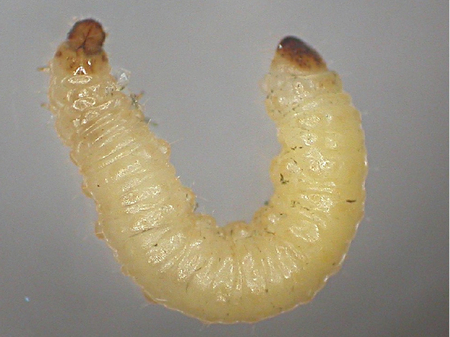
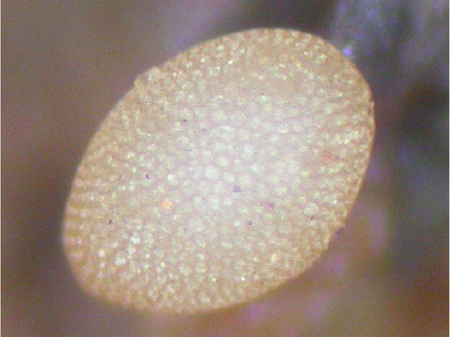
Biology
In our latitudes, the first beetles appear from mid-June, the main flight period extends from early July to early September. The beetle flight ends with the first frosts in October. After fertilization, the females first carry out a two-week maturing feeding on leaves, stigma threads, pollen and milky grains of the corn plants. They then lay an average of 300 to 400 eggs in the soil of corn fields at a depth of five to 20 cm. Neighboring fields may also be affected up to about 10 m from the edge of the field.
The corn rootworm overwinters in the egg stage, and a winter dormancy period of three to four months is essential for further development. The development of the three larval stages takes three to four weeks. The first larvae may hatch as early as the end of April, with peak larval emergence in May and June. After their feeding period, the larvae pupate in the soil in oval soil cocoons. The whitish, 3-4 mm long pupa already reveals the shape of the future beetle. This works its way to the soil surface after about a week of pupal dormancy.
The corn rootworm develops one generation per year. The duration of the individual development stages depends on the temperature. Depending on the weather, therefore, the time of larval hatching from the eggs in spring, the duration of larval and pupal development, or the flight times of the beetles can shift by several weeks, for example.
Damage symptoms
Economically significant is primarily the underground damage caused by the larvae of the corn rootworm. Young larvae bore into the fine roots, later stages feed on the outer layers of larger roots or also bore into their root tissue. This feeding damage impairs water and nutrient transport, promotes fungal infections and leads to loss of root stability. In severe infestations, the root ball can be completely destroyed, causing plants to lose their stability and easily fall over. Sometimes fallen plants can right themselves and curve upward (goose-neck symptom). Fallen plants cannot be harvested mechanically/barely.
The beetles feed on above-ground parts of the plants, mainly pollen, stigma threads, milky grains, and fresh leaves ("window feeding" as in cereal chickadee). This damage is only significant under certain conditions, such as when corn flowering coincides with the main flight period of the beetles and fertilization of the cobs is impaired by eaten stigma threads.
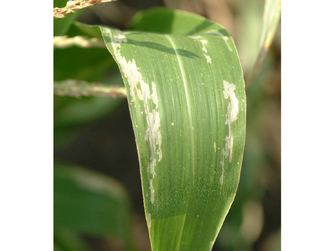
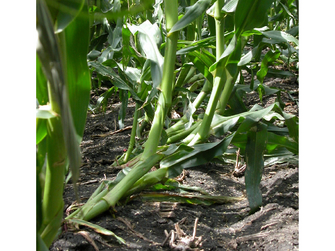
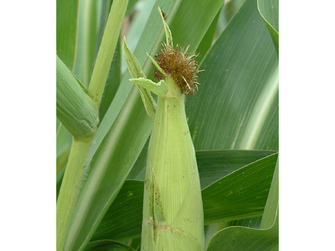
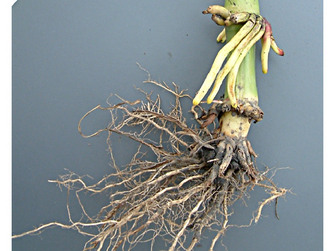
Host plants
The main host plant of the corn rootworm is corn(Zea mays L.). If corn roots are not available, the larvae may also use other grasses as host plants. For example, they have been detected on various bristle millet species(Setaria spp.).
In these cases, the mortality rate of the larvae is very high, but nevertheless, a small percentage may also fully develop into beetles. The beetles are sometimes also found on flowers (or pollen) of other plants (sunflowers, pumpkins).
Distribution
The corn rootworm has been widespread in North America for decades and is a feared pest, especially in the Midwest ("corn belt"), which is intensively used for corn cultivation. Hundreds of species of the genus Diabrotica are known in the Americas, but only this single species occurs in Europe. In North America, in addition to the Western corn rootworm described here, three other of these beetle species can be damaging to corn.
In Europe, the corn rootworm was first detected in 1992 in the vicinity of Belgrade. In the following years, the corn rootworm spread naturally in the Balkans and neighboring regions. Over the course of 15 years, two large contiguous infestations were established in this way, one in southeastern and eastern Europe, which includes important maize-growing areas in Austria, and a second in northern Italy. In addition, there are numerous smaller, isolated infestations, which are mostly located near airports or similar large cargo handling areas, e.g. in Italy, France, England, the Netherlands and Switzerland. Further spread in Europe cannot be prevented, but can be slowed down.
In Austria, the first corn rootworm beetles were caught in the summer of 2002 near the Slovakian border. Since then, the beetle has steadily spread further west and south and has been able to establish itself in the important maize-growing areas of Lower Austria, Styria, Carinthia and Burgenland. In Upper Austria, the beetles spread rapidly from 2007 onwards. Strong growth rates and new infestations had to be detected in the following years at previously infestation-free sites. At several locations in the Inn Valley, which are related to the distribution area in Bavaria, as well as in the Lienz area, the first isolated beetle findings were reported in 2012. In autumn 2015, the corn rootworm reached Vorarlberg for the first time.
Economic importance
In the USA, the corn rootworm is the most important pest of corn. Losses of around 30% are not uncommon, with peaks of up to 80% crop loss recorded in individual cases. The cost to control the pest is enormous and has earned it the nickname "billion dollar beetle." In Europe, losses of up to 50% have already been reported in Serbia, Hungary and Slovakia.
Prevention and control
Newly hatched young larvae can only migrate about 0.5 m. If they do not encounter food (corn roots) within this radius around the oviposition site, they die. Therefore, the simplest, most efficient and cheapest control method is to rotate the crop with maize only in the second, or better, in the third year. In addition, the emergence of corn in succeeding crops must be prevented. Eggs are also laid on cucurbits and soybeans near corn fields, making them less suitable for crop rotation than cereals, for example. Crop rotation is regulated by appropriate state ordinances.
Prevention
- early sowing in an optimally prepared seedbed
- sufficient and timely fertilization
- professional weed control
- irrigation
- selection of varieties with strong root growth or a high root regeneration rate
Chemical control
Control of the adult beetles is only possible with stilt tractors due to the height of the crop during the main flight period. Control of the larvae with soil insecticides (currently only granules) or seed dressing would be technically easier (see list of plant protection products approved in Austria).
Biological control methods
Biological control uses naturally occurring counterparts of the beetle larvae in the soil to reduce them in a natural way. Appropriate methods have already been investigated (antagonistic nematodes) or are still in the development stage (antagonistic fungi).
Biotechnical methods
Confusion techniques using sexual scents, as already successfully applied in orchards and vineyards, are used to try to prevent beetle mating and thereby reduce beetle populations. Most recently, emergency approvals for this agent have been obtained.
Specialized information
Projects
The aim of the "diacont" project was to bring novel methods for controlling corn rootworm to practical maturity.
Extensive trials have already been carried out on the use of insect-pathogenic nematodes of the species Heterorhabditis bacteriophora. The application of the nematodes as a suspension during sowing has proved successful. During sowing, the nematode suspension is applied to the seed furrow with the aid of an "injection nozzle" behind the press wheel and immediately covered again with soil. In the vicinity of the seed, the nematodes can now survive - protected from light and drought - for the period of about four to six weeks until the first beetle larvae appear in the soil. Previous trial results from us reflect a steady improvement in the trial methodology and initially showed varying efficacy, most recently an efficacy of 60-70%. A summary of our field trials over the last five years can be found under downloads.
In the "FlorAttDia" project, the use of scents to reduce corn rootworm is being researched. The beetles are strongly attracted to the flowers of the Styrian oil pumpkin and use both pollen and petals as a food source. The corn rootworm is oriented primarily by scent to locate the squash flowers. This preference for scents of squash blossoms is to be exploited. A bait system with flower scents of the Styrian oil pumpkin is being tested, which can control the beetles in a targeted and efficient manner and thus enable environmentally friendly plant protection in the regions of Austria affected by the corn rootworm. In addition to reducing the number of beetles in the maize stand, the traps loaded with the specific scents should also prevent the beetles from migrating from the maize into the neighboring pumpkin areas. This should help to ensure that crop rotation is also effective against the pest in the small-structured Austrian maize-growing regions with a high proportion of pumpkin in the crop rotation.
Film
In "The Billion-Dollar Beetle", the biology and behavior of the corn rootworm are illustrated and control measures against the pest are presented. The film is particularly impressive because of its numerous close-up shots. They show the pest, which is only a few millimeters in size, from a side that is largely hidden from the viewer's eye in the field. The DVD can be obtained from our Institute for Sustainable Plant Production at cost price of 32€ (including shipping).
Last updated: 10.10.2023
automatically translated